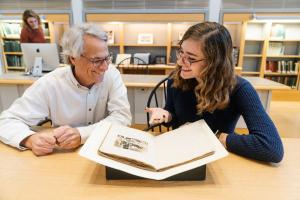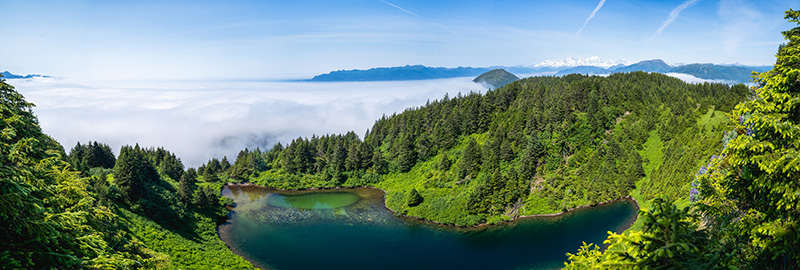
Support Undergraduate Research
Give the gift of life-changing, faculty-mentored research to Dartmouth undergraduates.
Five Thayer students immerse themselves in a week of on-site, real-time engineering.

Five Thayer School of Engineering undergraduates and Professor Doug Van Citters traveled to a remote Alaskan island in June to install a hydroelectric system for the Inian Islands Institute. The institute, an ecological field school founded by four Stanford PhD graduates, for years had relied on a diesel generator for power. Recently, however, the institute decided to switch to a greener energy source—a micro-hydroelectric system. Through a connection made by Professor Laura Ray, who served as interim dean for the past year, Thayer offered to send a team of students to do the actual installation.
Creating wise leaders who can think critically and communicate effectively is one of the principal goals of The Call to Lead. One way Dartmouth prepares future leaders is through immersive, experiential learning. With support from the Arthur L. Irving Institute for Energy and Society’s Experiential Learning Fund, these engineering students left for Alaska on June 20. They had one week to complete the job.
All photos by Kevin Yang
Doug Van Citters: One of the week’s biggest learning opportunities was to see that it’s one thing to design something at your desk, manufacture it, and change the design and repeat the process if necessary—and it’s totally different to make design changes on-site, in real time, with no equipment, no computer, and no plumber nearby. A good plan will help the ease of execution, but, in the end, you have to use your engineering skills and be a little bit clever to actually execute and complete the job.
Kevin Yang ’20: We tackle engineering problems for homework and labs, and if we do something wrong we might get a few points off, but we don’t fully realize what happens when a miscalculation occurs. In Alaska, we witnessed how a misaligned force vector of just a few inches becomes significant at that magnitude of water pressure and results in a pipe corkscrewing and bursting.
Doug: It took every minute of the seven days to get the system installed. Everything takes longer than expected, and for all of your planning things will fall apart. We needed a jackhammer at one point, and we didn’t have it. We resorted to a drill and a sledgehammer because that’s all we had.
Marisa Magsarili ’19: When you are out on a remote island and resources are limited, you are more aware of the amount of resources being used and the waste being produced. Working on the Inian Islands was a strong reminder about what organisms and ecosystems we are aiming to preserve when installing these renewable energy systems.
Doug: The students worked perfectly as a team, and they all had different skill sets. When our hammer drill broke, our sophomore representative, Abby, tore it down and fixed it.
Abby Brazil ’21: I was truly amazed at what we were able to accomplish in a week. I loved seeing the whole system get built piece by piece and being able to understand how all the parts come together to form the system.
Doug: We had to decommission the existing diesel generator as well as a hydro system that hadn’t been effective for decades. The property included 1,200 feet of six-inch pipe full of water, and because it had more than 300 feet of pressure head to it, we’re talking well over 130 PSI. There was a water explosion at one point, and all 1,700 gallons drained into the powerhouse, which means the generator, the batteries, and the inverter all got flooded. It took out the power and domestic water for the whole site.
Mallory Byrd ’19: Everybody kept their spirits up throughout the week. The powerhouse flooding was definitely the low point. There was water and mud everywhere. But later we were sitting on the steps looking out at this beautiful place on a gorgeous day—and we started to feel better. We reworked things the next day, and we got the new generator into the powerhouse much more easily than expected.

Doug: Onsite installation engineering may be hard work, but you can see exactly what you’ve done. It’s not conceptual anymore. It’s real and rewarding.
Ben Saccone ’20: We all knew going into the experience that we’d learn about hydropower, but I found that some of the most fascinating moments happened off the job. It isn’t often possible to be transported into the midst of a group of people similarly passionate about the environment, but this was one of those opportunities. Dinner could be a platform for discussions of climate justice viewed through a socioeconomic lens and short breaks were a great time to learn about the nuances of living in Alaska.
Dartmouth established the Arthur L. Irving Institute for Energy and Society to be one of the world’s leading institutes for advancing humankind’s understanding of global energy issues. Grounded in the belief that energy and society are linked and should be studied in tandem, the Irving Institute advances energy-related pedagogy, research, and outreach that encompasses the breadth of Dartmouth’s schools and academic departments, including the arts and sciences, business, engineering and medicine.
You can help make the world a classroom for energy issues by giving to the Irving Institute’s Experiential Learning Fund.